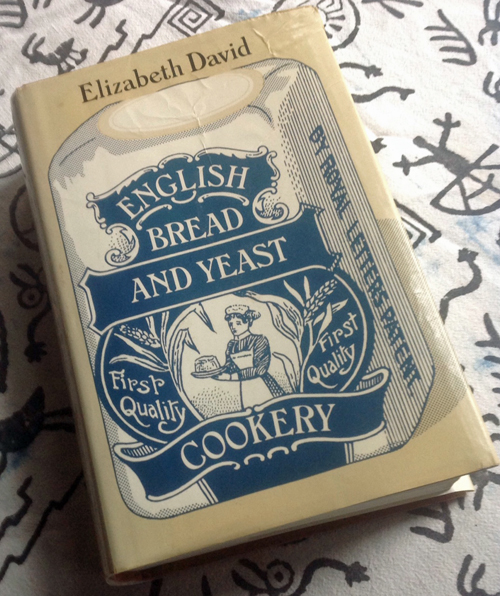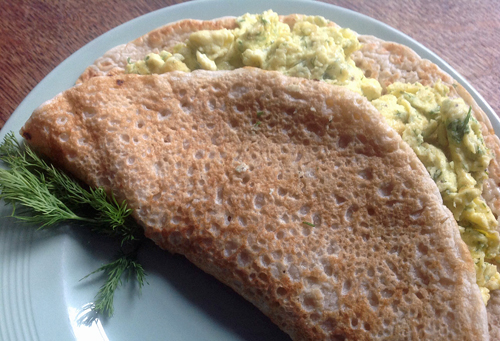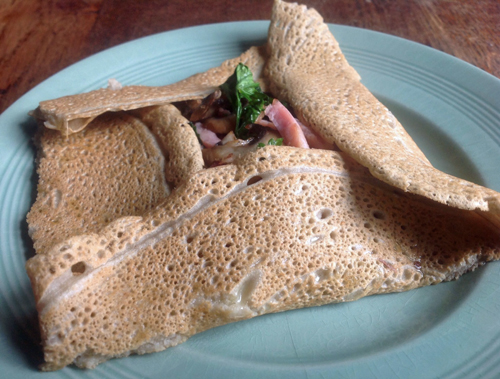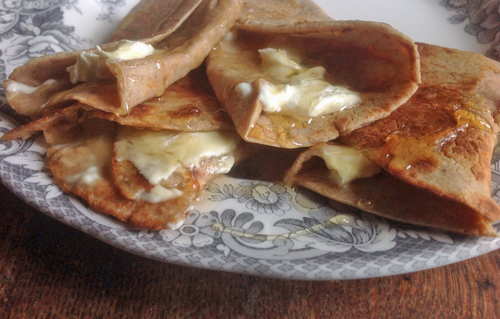Pancakes, crêpes, flapjacks, riddle cakes, galettes… My kitchen has been filled with the results of experiments with griddle batter cakes – savoury and sweet. Yes, it’s that time of year, nearly Shrove Tuesday – also known as Pancake Day here in Britain. It marks the end of Carnival and the beginning of Lent.
Most of my experiments have dealt with non-wheat flours – buckwheat, barley, oat, chestnut. All but the chestnut flour came from the nearby Caudwells Mill in Rowsley, Derbyshire – now a listed building and historic museum in the heart of the Peak District. The golden barley pancakes (as seen in the image at the beginning of this post) were inspired by Finnish barley flatbread, Ohrarieska – see my earlier post At the Mill – made with barley flour, sweetened with a small amount of vanilla sugar and spiced with a pinch of ground cardamom. I was also on the trail of an Icelandic rye pancake, but as yet have not found an authentic recipe. My other experiments, however, followed tried-and-true traditional English and Continental European recipes.
In my kitchen is my 1977 edition of Elizabeth David’s English Bread and Yeast Cookery. It is particularly useful for history and lore of traditional English breads and flat cakes, baps and rolls, crumpets and muffins, dumplings and doughnuts, etc. and etc. I am not normally a fan of standard store-bought British bread (too dry, too tasteless, too soft crusts), but many of the forgotten regional and festival breads described in this book – especially the yeasty pancakes made with oats, barley and buckwheat – are well worth reproducing.
Soft scrambled eggs with dill make a great filling for my traditional Derbyshire oatcakes. These are large flat griddle cakes much like crêpes, but made with a mixture of fine ground oats and wheat flour. Because they are made with yeast, they’re like flat, floppy, oaty crumpets. Traditionally these are served with sausage, bacon, black pudding, egg and other elements of a “Full English Breakfast” (see my earlier post Not Your Typical Oatcake).
Unlike the English buckwheat pancakes described in Elizabeth David’s book, French galettes are not made with yeast. They are thin, more like crêpes, made simply with buckwheat flour, salt, water and eggs. They are often filled with savory ingredients – like melted Gruyere cheese, smoky ham and sautéed mushrooms. Customarily, they are folded, making a square basket for the filling.
Necci are traditional chestnut flour crêpes made in the Garfagnana region of Tuscany – the chestnut growing area near the town of Lucca (homeland of Puccini). They are usually filled with ricotta (sometimes sweetened with honey) but also served with prosciutto or other cured meats. Absolutely yummy!
In my kitchen is my iPad – the perfect tool for culinary (pancake) research. It is always to hand with internet access plus scads of historical, out of copyright cookbooks downloaded and stored in iBooks. By a mere fluke, I stumbled upon a recipe from the 18th century for pink pancakes in The Experienced English Housekeeper by Elizabeth Raffald (1786 edition). The cookbook devotes three pages to pancake making – using such ingredients as beetroot (the pink in the pink pancakes), orange flower water, tansy juice, clary (a type of sage), brandy and the more common nutmeg. Even with my love of kitchen experimentation, I was quite hesitant in reproducing this particular pink pancake. I have learned from experience that tastes from by-gone days do not always tempt the modern palate!
Putting the pancakes aside, what I’d really like to know is where have all the doughnuts gone? Growing up, heavily influenced by my Pennsylvania Dutch grandmother, Shrove Tuesday was always celebrated with doughnuts, not pancakes. It was Fasnacht Day. I should perhaps explain here that the Dutch in Pennsylvania Dutch is actually a corruption of Deutsch and therefore German ancestry, not Dutch. Fasnachts are fried doughnuts made and eaten on the Eve of Lent, common not only in Eastern Pennsylvania, but in Southern Germany and neighboring areas. So…I dug out my grandmothers old cookbooks and found her recipe. I made mounds of two types of mini fasnachts – one covered in cinnamon sugar and the other in confectioners’ sugar. Shrove Tuesday = Pancake AND Doughnut Day!
In my kitchen are Lenten Roses – Hellebores – from the garden. I’ve planted them in strategic spots near entrances to the house in accordance with an old Welsh superstition that says they ward off evil and protect the home. They bloom just in time for Lent. Just in time, too, for a little fasting after all those pancakes and doughnuts.









Great post, very informative!
LikeLike
Thanks Melissa!
LikeLike
Great post Deb! This morning I made pancakes with 100% sourdough starter I would have otherwise discarded. They were light and fluffy and just a tiny bit sour. I’m going to try your French buckwheat pancakes, I usually mix buckwheat with some gluten free flour which is just a bit too refined for my liking! My edition of ED’s book is a bit more modern than yours and not nearly as attractive!
LikeLike
Got my copy of ED secondhand – but back in the 80s when my husband and I used to trawl the used bookstores in Cambridge (pre-kids!!). I didn’t use it much at first, but simply love ED’s other books and thought I should complete the collection. Now that I’ve come back to it, I’m finding it a mine of information and some rather wonderful recipes. Your sourdough pancakes sound interesting. The galette recipe I used came from Susan Loomis’s cookbook, French Farmhouse Cookbook.
LikeLike
Deb, in the days before we worried about cholesterol and gluten I used to often make the blue cheese tart with a yeast crust from the Yeast Cookery Book. It’s incredibly rich, but oh so good!
LikeLike
That sounds scrumptious and very rich! I have my eye on crumpets, which ED details from 18th century to modern day. Rich only if you slather on the butter!
LikeLike
This is a wonderful post, inspiring me to get going thinking about Tuesday… Just checking that you know the absolutely wonderful book Pennsylvaia Dutch Country Cooking– full of lore and history and really interesting recipes.
LikeLike
whoops– by William Woys Weaver– a lucky charity shop find for me…. you would love it!
LikeLike
Thanks for the suggestion. I didn’t know about the book. Some of my grandmother books date back more than 60 years ago – most are pamphlets published in small runs in Lancaster County PA. I posted a picture of the front cover of one of them in an early post on Fritters. I’ll have to keep my eye out for the one you mentioned. Happy pancake making!
LikeLike
Grandmothers’ pamphlets are the best 🙂
LikeLike
I love combing the second hand bookshops for old cookbooks! Brilliant post – I have been thinking for some time now that I would like to post to IMK – You have inspired me now, so I may just do it this month.
LikeLike
I really love writing my IMK posts and I think you will, too. Second hand shops are marvellous places to find old cookbooks.
LikeLike
What an informative and delicious post! Thanks for putting in all the history with some beautiful pancakes.
I’m going to make pancakes on Tuesday- you’ve totally inspired me!
LikeLike
I love pancakes and I love history…so what else could I do? 🙂 Happy pancake making tomorrow! We’re doing the buckwheat ones for savory and the chestnut ones for sweet. The family voted!
LikeLike
Pancakes and doughnuts. Perfect.
LikeLike
Agree!
LikeLike
Lots of great information 🙂
LikeLike
I aim to please! 🙂
LikeLike
🙂 x
LikeLike
Your kitchen must smell divine! My grandmother lived on a farm at the very top of Maine on the Canadian border. What I always remember are her buckwheat pancakes which were called ‘ploy’. They were made with buckwheat but you need a starter (like a sourdough starter) to make them the way she did. She would cook them right on the top of her big black woodstove and they were served with every meal instead of bread. Slathered with homemade butter – just couldn’t be beat.
LikeLike
I was so intrigued by your “ploy” that I had to look them up. They’re Acadian French, sometimes spelled “ploye”, but ultimately derive from the French buckwheat galette. Although, recipes vary – usually according to some family tradition. Your sourdough starter addition would be fabulous. I bet you loved your grandmother’s kitchen.
LikeLike
That’s exactly correct & where my grandparents lived was more closely affiliated with Canada than the US and they all spoke French in that area. The ploy have the buckwheat taste but the texture is more like a crepe…so good.
With 9 kids my grandmother spent most of her time in that kitchen. I laugh when I think of how everyone is so worried about the precise temperature of their oven when this woman could bake to perfection with a wood burning stove.
LikeLike
G’day! What a great informative post I REALLY enjoyed today!
I always enjoy learning something new…may I have a donut now?
Thank you for this month’s kitchen view!
Cheers! Joanne
LikeLike
Hi Joanne. I wish I could ship those doughnuts to you, but unfortunately husband and son have scoffed them up. Love delving into the whys and wherefore of things. Glad you enjoyed the post.
LikeLike
Only one word to describe this post. YUM!!!
LikeLike
Thanks!
LikeLike
Loved…… this post…!. I can imagine the aromas in your kitchen as you worked…. Our family loves pancakes on Sunday evening sometimes in the winter….. with ham and fruit… or sour cream and fried apples…. and crepes with oranges and boiled custard…. Yum… Is pancake day celebrated by many in Britain? sue
womenlivinglifeafter50.com
LikeLike
Pancakes are really wonderful and so soul satisfying on a cold day. I love them with ham or bacon and like any proper American, with maple syrup. Pancake day is celebrated by most – religious or not – here in Britain. It’s just one of those things.
LikeLike
Lovely post Debi! What fun you’ve been having with your pancakes and those fantastic looking doughnuts! I don’t always have much luck with very old recipes either, nor with ones from the 70s and 80s that call for margarine and tinned brie! 🙂
LikeLike
Tinned brie – that’s a new one on me. Yes, one has to “interpret” old recipes in order to first decide if they are worth reproducing and second how to do it! We had lovely fun with pancakes. Family and friends couldn’t decide which was better than the other. We liked them all, but oh so filling! Need a little non-pancake time now.
LikeLike
Oh my gosh I love your “crêpe-esque” oat cakes. This is a wonderful post. So interesting using an old cookbook and getting such fabulous results. And your doughnuts look so fun. I remember my mom making doughnuts. It was always such a special occasion.
LikeLike
Doughnut making is special, but not to be taken lightly. All that bubbling oil and the countertops covered in powdered sugar. It was worth the mess. The oatcakes are very, very good and really worth doing. Easy, too.
LikeLike
Impressed by your pancakes and would love a copy of that lovely old Elizabeth David book, but your doughnuts are the most amazing – incredible.
LikeLike
Thanks! I got that book many many years ago in a second-hand bookseller in Cambridge, but have only begun to appreciate it. I just saw Elizabeth David’s name and bought it since I had and loved her other more Mediterranean oriented books. I think I’m on to home-made crumpets next – maybe with barley flour.
LikeLike
Fascinating post, and I love the photography; interesting how traditions about Lent differ. I like old cookbooks, too, and cherish my copy of Granddaughter’s Inglenook Cookbook from my grandmother from 1942–it heavily leans on Pennsylvania Dutch customs as does the original Inglenook Cookbook. I’d like to do some blog posts based on the cookbook sometime.
LikeLike
I love traditions! There are so many of them in the US, some based on Old World ones and some new. I find it fascinating delving into them. I’m also discovering from your posts, but others as well, that Pennsylvania Dutch food isn’t restricted to Pennsylvania! Old cookbooks are a great source of history as well as recipes! Thanks for visiting!
LikeLike
Just stumbled across your blog and it is gorgeous. Very interesting to read about the history and the pancakes look amazing! Looking forward to exploring the rest of your site x
LikeLike
Thanks very much! Glad you like the blog. Hope to see you back again soon!
LikeLike
[…] honey. I made these for Pancake Day (Shrove Tuesday), reporting on my first attempts in my post In My Pancake Kitchen, but they were so good (as you can see in the photo), that I thought I should make them again and […]
LikeLike
This post sent me straight to dig out my own copy of Elizabeth David. I love cooking with alternative flours, particularly oat & barley so thank you for the reminder. A fabulous post & so informative.
LikeLike
It’s a fab book! I had it on the shelf for years before I actually started delving into it in a meaningful way (i.e. actually reading it!). I’m so glad the post inspired you.
LikeLike
Debi, I loved this pancake primer — such interesting recipes and flavors! Thank you for doing so much research. The scrambled egg & dill filled oatcake and chestnut crepes sound fabulous (all of them do!) and I especially enjoyed the history behind your doughnuts.
LikeLike
You are very welcome. I had recently been to our local mill (Caudwell’s Mill in Derbyshire) where I bought a number of kilos of different types of flour. And, since we were having people over to celebrate Pancake Day, I had a splurge ahead of time experimenting with different types of pancakes. I also love my non-stick frying pan which is ideal for pancake making. It really is an essential tool, particularly for crepes.
LikeLike